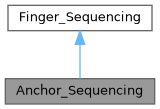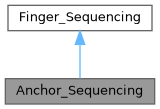#include <GenericSequencing.h>


Public Member Functions | |
| void | set_status () override |
| void | operator() (const col_type ct, const float &now) override |
| sequence updating given the column type and time of current row | |
| float | get_ms () override |
 Public Member Functions inherited from Finger_Sequencing Public Member Functions inherited from Finger_Sequencing | |
| virtual void | full_reset () |
| virtual void | check_status () |
| based on the anchoring status, do an action | |
Additional Inherited Members | |
 Public Attributes inherited from Finger_Sequencing Public Attributes inherited from Finger_Sequencing | |
| col_type | _ct = col_init |
| anch_status | _status = anch_init |
| int | _len = 1 |
| float | _sc_ms = ms_init |
| same-column ms: time between now and previous tap | |
| float | _max_ms = ms_init |
| float | _len_cap_ms = ms_init |
| float | _last = s_init |
| row_time of last note on this col | |
| float | _start = s_init |
Detailed Description
Anchors; effectively the same as jacks, but handled slightly differently. If you are struggling with the notion that a 300 bpm oht is considered 2 anchors of roughly equivalent lengths (depending on where you sample) and equivalent times, the difference between an anchor and a jack is that one cares about the existence of notes on other columns while the other doesn't, as in, it would make far less sense to call them jacks
Member Function Documentation
◆ get_ms()
|
inlineoverridevirtual |
returns an adjusted MS average value, not converted to nps (((currently unused)))
Implements Finger_Sequencing.
◆ operator()()
|
inlineoverridevirtual |
sequence updating given the column type and time of current row
Implements Finger_Sequencing.
◆ set_status()
|
inlineoverridevirtual |
Set the status of this anchor. Break the anchor if the next note is too much slower than the lowest one in the sequence. Remember, if we reset, the start of the new anchor was the last row_time, and the new max_ms should be the current ms value.
Implements Finger_Sequencing.
The documentation for this struct was generated from the following file:
- /home/runner/work/etterna/etterna/src/Etterna/MinaCalc/Dependent/HD_Sequencers/GenericSequencing.h